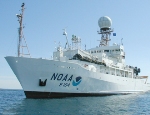
CalNex Project Uses $20 M to Examine Air Pollution, Climate Change

The California Air Resources Board and the National Oceanic and Atmospheric Administration are taking to land, sea and air to address the most challenging aspects of California’s air quality problem: measuring greenhouse gases and air pollutants.
The $20 million CalNex project is employing an unprecedented number of airplanes, ships and researchers to examine the nexus between air pollution and climate change.
"Combining resources with NOAA will give California new data to link our clean air and global warming protection efforts,” said ARB Chair Mary D. Nichols. “The scale and sophistication of CalNex represents a milestone in ARB's 40-year history of groundbreaking air pollution research."
CalNex is the culmination of three years’ preparation and more than $20 million in funding. Started in early May continuing through most of June, the project will involve four airplanes, an ocean-going research ship, two land-based air monitoring super sites and more than 150 highly trained scientists.
The project builds upon the idea that air quality and climate change issues are linked through "one atmosphere," an approach that demands coordination and multi-tiered approaches.
Along with recent efforts to address climate change, ARB provides its leadership in air pollution studies with decades of baseline air quality data, an ongoing atmospheric monitoring capacity and existing research capabilities. NOAA brings its ability to rapidly study the atmosphere over large areas of ocean and land by employing large, richly instrumented, long-range aircraft, a fully capable oceanographic vessel and their experienced scientists.
The scale of the operation is unprecedented for an atmospheric research project in California. The project is employing:
- Four aircraft ─ NOAA: WP-3D, Twin Otter and CIRPAS’ Twin Otter, and NASA: King Air;
- A research vessel (NOAA’s Atlantis);
- Two ground air monitoring super sites;
- Caltech with over 40 investigators will focus on organic or carboneous particulate matter and nighttime chemistry; and
- Arvin (Kern County) with 18 investigators, who will provide a comprehensive suite of chemical measurements.
NOAA’s contribution of hardware and expertise is estimated at $15 million. California is contributing $5 million, as well as the expertise of their meteorological, modeling, monitoring and research staff. Researchers from all over the United States and Europe will also be on the teams collecting data.
The data collected will give scientists a better understanding of atmospheric-chemical transformations, climate processes, transport and meteorology. This will improve ARB’s methodologies for measuring greenhouse gases, traditional air pollutants and their precursors. In addition, the study will improve ARB’s understanding of the atmospheric formation of ground-level ozone and PM that will improve air-quality models which in turn enables ARB to develop more effective control strategies.